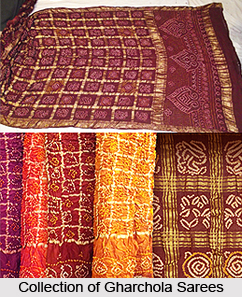 Gharchola Sarees are also known as "Ghatchola" and "Gharcholu" which has its origin in Gujarat. These sarees are traditionally bought for wedding purpose. Gharchola has been a significant outfit in a Hindu wedding, especially in North India. The name "Gharchola" means "Outfit for Home", which symbolizes a newly wedded bride joining her new home. This saree makes a wedding or any other ritual a scenic and picturesque occasion.
Gharchola Sarees are also known as "Ghatchola" and "Gharcholu" which has its origin in Gujarat. These sarees are traditionally bought for wedding purpose. Gharchola has been a significant outfit in a Hindu wedding, especially in North India. The name "Gharchola" means "Outfit for Home", which symbolizes a newly wedded bride joining her new home. This saree makes a wedding or any other ritual a scenic and picturesque occasion.
Though Kutch has retained its traditional designs and colour schemes, other centers in Gujarat, mainly Jamnagar, are producing "modern versions" using unconventional colour schemes and fancy designs. Although weaving and tying work is done at Khambhat, but for dyeing and block printing on sarees, it was sent to Jamnagar where brilliant shades are produced due to superior water quality of the region. The art of Gharchola saree making has also spread to other cluster like Joravarnagar, Kataria under Surendranagar district.
Symbolism of Gharchola Sarees
Gharchola Sarees are the most symbolic element of a Hindu or Jain wedding in Gujarat. A Gharchola Saree is a gift from the mother-in-law to the newly-wedded bride, which the bride would change into as soon as she stepped into her new home. This signifies that the in-laws have taken the responsibility of the bride.
Making of Gharchola Sarees
The Gharchola Sarees are woven on Cotton or Silk fabric in large checks of using Silk and Zari threads. These checkered patterns are filled with small golden motifs like a peacocks, lotus, human figures and floral designs in the center. Lavish use of zari and thread enhances its beauty. These sarees are tied and dyed in Kutch. A typical Gharchola is made in Red color, embellished with yellow and white dots, and is 5.5 m in length and 46 inches in width. The making of a Gharchola is an intricate and a time consuming process.
Varieties of Gharchola Sarees
Gharchola Sarees are generally available in two varieties depending on the quality of zari used in checks and squares in the sarees. The entire body of the saree is covered with repeat designs in squares. The most popular variety of these Gharchola sarees comes in a combination of red and white or red and green. Other than these, a Gharchola Saree with 12 squares is known as "Bar Bagh", while the one with 52 squares is known as "Bavan Bagh". Where more than two colors are used, the design is known as "Phulwari" or garden and where animal motifs predominate it is known as "Shikari" which means hunting scene. Another popular pattern is "Raas Leela".
Maintenance of Gharchola Sarees
A Gharchola Saree is recommended to dry clean the saree for its longevity and keeping it away from direct sunlight. Since it"s made of silk with some intricate detailing on it, a little care is required to keep the fabric in great shape for an extended time.





















